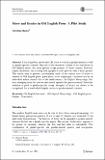Files in this item
Mann and gender in Old English prose : a pilot study
Item metadata
| dc.contributor.author | Rauer, Christine | |
| dc.date.accessioned | 2016-06-14T12:30:08Z | |
| dc.date.available | 2016-06-14T12:30:08Z | |
| dc.date.issued | 2017-01 | |
| dc.identifier | 243084261 | |
| dc.identifier | 1722cee4-6693-4e5e-86f8-f783c1697ed3 | |
| dc.identifier | 84974806890 | |
| dc.identifier | 000392292700011 | |
| dc.identifier.citation | Rauer , C 2017 , ' Mann and gender in Old English prose : a pilot study ' , Neophilologus , vol. 101 , no. 1 , pp. 139-158 . https://doi.org/10.1007/s11061-016-9489-1 | en |
| dc.identifier.issn | 0028-2677 | |
| dc.identifier.other | ORCID: /0000-0002-7593-0152/work/60426833 | |
| dc.identifier.uri | https://hdl.handle.net/10023/8978 | |
| dc.description.abstract | It has long been known that OE mann was used in gender-neutral as well as gender-specific contexts. Because of the enormous volume of its attestations in Old English prose, the more precise usage patterns of mann remain, however, largely uncharted, and existing lexicographical tools provide only a basic picture. This article aims to present a preliminary study of the various uses of mann as attested in Old English prose, particularly in its surprisingly consistent use by an individual author, namely that of the ninth-century Old English Martyrology. Patterns emerging from this text are then tested against other prose material. Particular attention is paid to gender-specific usage, examples of which are shown to be exceptional for a word which largely occurs in gender-neutral contexts. | |
| dc.format.extent | 387168 | |
| dc.language.iso | eng | |
| dc.relation.ispartof | Neophilologus | en |
| dc.subject | Old English literature | en |
| dc.subject | Old English Martyrology | en |
| dc.subject | Old English prose | en |
| dc.subject | Gender | en |
| dc.subject | Translation | en |
| dc.subject | PE English | en |
| dc.subject | 3rd-NDAS | en |
| dc.subject | BDC | en |
| dc.subject | R2C | en |
| dc.subject.lcc | PE | en |
| dc.title | Mann and gender in Old English prose : a pilot study | en |
| dc.type | Journal article | en |
| dc.contributor.institution | University of St Andrews. School of English | en |
| dc.contributor.institution | University of St Andrews. St Andrews Institute of Medieval Studies | en |
| dc.identifier.doi | 10.1007/s11061-016-9489-1 | |
| dc.description.status | Peer reviewed | en |
This item appears in the following Collection(s)
Items in the St Andrews Research Repository are protected by copyright, with all rights reserved, unless otherwise indicated.

